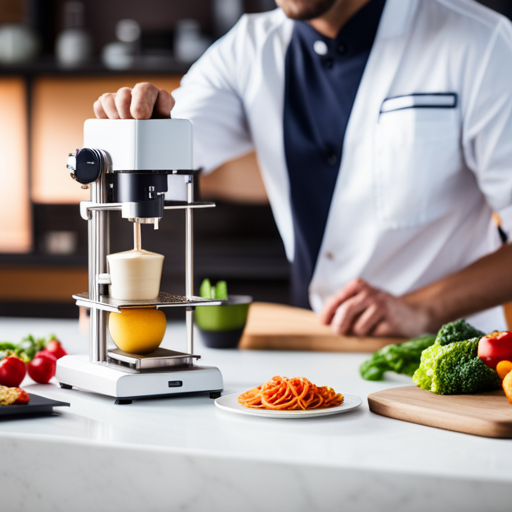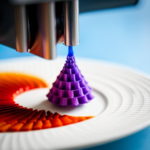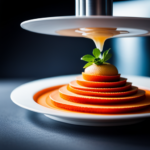Breaking new ground in the culinary world, the rise of food 3D printing has revolutionized the way we perceive and present food. From intricately designed desserts to visually stunning entrees, this innovative technology has sparked a wave of creativity and customization in the hospitality industry.
In this article, we explore the profound impact of 3D printed food on food presentation, uncovering its history, advantages, and future trends. Join us on a journey through the cutting-edge landscape of culinary artistry.
History of Food 3D Printing
Since its inception in the early 2000s, food 3D printing has rapidly evolved, revolutionizing the culinary landscape. This technology has seen a remarkable evolution, initially starting with basic shapes and designs and advancing to more intricate and detailed culinary applications. The evolution of technology has seen food 3D printing move from being a novelty to a potentially game-changing tool for chefs and food enthusiasts alike.
The early stages of food 3D printing primarily focused on creating simple confections and decorative items, but as the technology progressed, its culinary applications expanded to include the production of complex structures, customized shapes, and even personalized nutrition. The evolution of food 3D printing technology has brought about a significant shift in the culinary world, offering chefs the opportunity to experiment with unique presentations and flavors.
It has opened up a realm of possibilities for creating visually stunning dishes that were previously unattainable through traditional means. This innovation has the potential to not only enhance the dining experience but also to address challenges in food production and sustainability.
Advantages of 3D Printed Food
The utilization of 3D printed food offers numerous advantages in culinary innovation and presentation. This cutting-edge technology allows for personalized experiences and sustainability benefits, revolutionizing the way food is prepared and presented.
| Advantages of 3D Printed Food | |
|---|---|
| 1. Personalized Experiences | 3D printing enables chefs to create intricate and customized designs, catering to individual preferences and dietary restrictions. This level of personalization enhances the dining experience and allows for a more tailored approach to food presentation. |
| 2. Precision and Consistency | The precision of 3D printing ensures uniformity in portion sizes and presentation, leading to a consistent dining experience for customers. This level of accuracy is challenging to achieve through traditional methods. |
| 3. Waste Reduction | By using precise measurements and only utilizing the necessary ingredients, 3D printed food reduces waste in the kitchen, contributing to sustainability efforts. |
| 4. Creative Freedom | Chefs can unleash their creativity by experimenting with shapes, textures, and structures that were previously unattainable through conventional cooking methods. This fosters innovation and uniqueness in food presentation. |
| 5. Nutritional Control | 3D printing allows for precise control over the nutritional content of the food, enabling chefs to create healthier options without compromising on taste or presentation. |
These advantages demonstrate the transformative impact of 3D printed food on the culinary industry, offering a new realm of possibilities for chefs and enriching the dining experience for consumers.
Impact on Culinary Creativity
The introduction of 3D food printing has revolutionized the way chefs approach food presentation, offering a myriad of enhanced plating possibilities.
This technology has sparked a culinary art evolution, encouraging chefs to push the boundaries of creativity and design in their dishes.
With the ability to construct intricate and personalized shapes and textures, 3D food printing has become a powerful tool for culinary innovation and artistic expression.
Enhanced Plating Possibilities
Food 3D printing technology has revolutionized culinary creativity by introducing enhanced plating possibilities. Chefs are now able to create intricate and visually stunning dishes using advanced 3D printing techniques, enhancing the overall visual appeal of their culinary creations.
This technology allows for the production of bespoke molds, stencils, and decorations that were previously unattainable through traditional methods. The ability to customize and produce intricate designs enables chefs to elevate the presentation of their dishes, adding a new dimension to the dining experience.
Culinary Art Evolution
Culinary art evolution through the integration of 3D printing technology has significantly impacted and expanded the realm of culinary creativity. This evolution is evident in the way chefs are reimagining the presentation of dishes, leading to the evolution of plating techniques that elevate the sensory experience for diners. The use of 3D printing allows for intricate designs and structures that were previously unattainable, offering new possibilities for chefs to express their culinary artistry. The table below illustrates the impact of 3D printing on culinary art evolution:
| Evolution of Plating | Sensory Experience | Culinary Creativity |
|---|---|---|
| Intricate designs | Enhanced flavors | Unparalleled novelty |
This technological integration has revolutionized the way dishes are conceptualized and presented, providing chefs with a new dimension for culinary innovation. This evolution not only enhances the visual appeal but also transforms the entire dining experience.
Now, let’s delve into the subsequent section about ‘enhancing visual appeal’.
Enhancing Visual Appeal
Enhancing visual appeal in food presentation through 3D printing opens up a world of innovative plating techniques, allowing chefs to create mesmerizing and intricate designs that captivate diners.
Customizable food designs enable chefs to tailor dishes to specific themes, events, or even individual preferences, adding a personalized touch to culinary creations.
The use of 3D printing technology also fosters the creation of artistic culinary masterpieces that push the boundaries of traditional food presentation, elevating the dining experience to new levels of creativity and aesthetic delight.
Innovative Plating Techniques
Utilizing innovative plating techniques is essential for enhancing the visual appeal of dishes in the realm of 3D printed food presentation.
Plating innovation has taken a significant leap with the integration of modern techniques, leveraging the capabilities of 3D printing to create visually stunning culinary presentations.
One such technique involves the use of intricate three-dimensional molds to shape and structure food elements, adding depth and complexity to the overall design.
Additionally, the precision of 3D printing allows for the production of customized plating tools, enabling chefs to experiment with unconventional shapes and forms that were previously unattainable.
The result is a fusion of artistry and gastronomy, where innovative plating techniques not only elevate the aesthetic appeal of dishes but also offer a new dimension of creativity and expression in the culinary world.
Customizable Food Designs
In the realm of 3D printed food presentation, chefs are leveraging customizable food designs to enhance the visual appeal of their culinary creations. The customization options and design flexibility offered by 3D food printing allow chefs to create intricate and visually stunning dishes that were previously unattainable through traditional culinary methods. From geometric patterns to personalized shapes, the ability to customize food designs opens up a world of creative possibilities, enabling chefs to elevate the presentation of their dishes to new heights.
| Customization Options | Design Flexibility |
|---|---|
| Geometric patterns | Personalized shapes |
| Intricate details | Unique textures |
| Edible decorations | Elaborate structures |
This innovative approach not only enhances the aesthetic appeal of food but also provides a unique dining experience for patrons, setting a new standard for culinary artistry.
Transitioning into the subsequent section about ‘artistic culinary creations’, the focus shifts to the impact of these customizable food designs on the overall dining experience.
Artistic Culinary Creations
Leveraging the customizable food designs enabled by 3D food printing, chefs are creating artistic culinary creations that enhance the visual appeal of their dishes, incorporating intricate details, unique textures, and elaborate structures to elevate the dining experience. This culinary technology allows for the manifestation of unprecedented visual aesthetics in the following ways:
-
Intricate Designs: Chefs can now craft stunningly detailed designs that were previously unattainable using traditional culinary methods.
-
Unique Textures: 3D food printing enables the incorporation of diverse textures, adding depth and sophistication to dishes.
-
Elaborate Structures: Chefs can construct intricate and elaborate food structures, such as delicate sugar sculptures or interlocking savory creations, enhancing the artistic presentation of their dishes.
These innovative approaches not only captivate diners visually but also showcase the limitless possibilities of incorporating 3D food printing in culinary arts.
Customization and Personalization
Food 3D printing has revolutionized food presentation by enabling chefs to achieve a new level of customization and personalization in their culinary creations. This technology allows for personalized experiences, where chefs can cater to the specific preferences and dietary requirements of individual customers. Creative expression reaches new heights as chefs can experiment with intricate designs and unique shapes that were previously unattainable. The ability to customize and personalize dishes through 3D printing empowers chefs to offer truly innovative and memorable dining experiences.
Furthermore, 3D printing enables the creation of personalized food items that cater to specific nutritional needs, allergies, and taste preferences. Chefs can design and produce intricate patterns, logos, or even personal messages directly onto the food, elevating the dining experience and creating a strong emotional connection with the consumer.
However, while customization and personalization through 3D printing offer numerous benefits, there are also challenges and limitations that must be considered in order to fully understand the impact of this technology on the culinary world.
Challenges and Limitations
Addressing the challenges and limitations of food 3D printing technology is essential for understanding its full impact on the culinary industry. While food 3D printing has made significant technological advancements, there are still several limitations that need to be overcome to fully integrate this technology into mainstream food presentation and consumption.
-
Material Limitations: One of the primary challenges of food 3D printing is the limited range of printable ingredients. Currently, most food 3D printers can only work with specific types of ingredients, such as chocolate, cheese, and certain types of dough. Expanding the range of printable materials to encompass a wider variety of foods is crucial for the widespread adoption of this technology.
-
Complexity of Designs: Creating intricate and detailed designs with food 3D printing can be challenging. While advancements have been made in simplifying the design process, the technology still faces limitations in reproducing highly complex and delicate food structures accurately.
-
Speed and Efficiency: Another limitation of current food 3D printing technology is the speed and efficiency of the printing process. In many cases, 3D printing food items can be time-consuming, making it impractical for high-volume food production settings.
Overcoming these limitations through continued technological innovation will be essential for the broader integration of food 3D printing into the culinary industry.
Future Trends in Food Presentation
To propel food 3D printing technology into the future of food presentation, it is imperative to anticipate and adapt to upcoming trends that will shape its integration into culinary practices. Future trends in food presentation are shifting towards a stronger emphasis on visual aesthetics, where innovative techniques and technologies, such as 3D printing, play a pivotal role. The integration of 3D printing into food presentation opens up a realm of possibilities for creating stunning visual experiences that were previously unattainable through traditional methods.
| Future Trends in Food Presentation |
|---|
| 1. Customized Food Designs |
| 2. Sustainable and Eco-Friendly |
| 3. Interactive Dining Experiences |
| 4. Fusion of Art and Food |
| 5. Virtual Reality Integration |
These trends represent an exciting shift in the culinary landscape, where food presentation becomes an art form, captivating diners through visually striking and immersive experiences. As 3D printing continues to evolve, it is poised to revolutionize how food is not only prepared but also presented, offering endless opportunities for chefs and food designers to push the boundaries of creativity in the culinary world.
This evolution will significantly impact the hospitality industry, where 3D printed food is set to transform the landscape of culinary experiences and redefine the concept of gastronomy.
3D Printed Food in the Hospitality Industry
The integration of 3D printing into food presentation is poised to revolutionize the hospitality industry, ushering in a new era of culinary experiences and setting the stage for the widespread adoption of 3D printed food. As the hospitality industry embraces this innovative technology, several key factors come into play:
-
Customization: 3D printing allows for the creation of highly customized and intricate designs, catering to diverse consumer preferences. This level of personalization enables chefs to craft visually stunning and unique dishes that resonate with their patrons.
-
Efficiency: The use of 3D printing in food preparation can streamline processes, leading to more efficient kitchen operations. This not only enhances productivity but also contributes to a reduction in food waste, aligning with the growing emphasis on sustainability within the industry.
-
Novel Experiences: By incorporating 3D printed elements into their menus, hospitality establishments can offer patrons novel and immersive dining experiences. This innovative approach can captivate consumers, attracting those seeking cutting-edge culinary adventures.
The adoption of 3D printing applications in the hospitality industry represents a shift towards meeting evolving consumer preferences while pushing the boundaries of creativity and presentation in the culinary world.
Frequently Asked Questions
How Does 3D Printing Technology Impact the Nutritional Value of the Printed Food?
3D printing technology impacts nutritional value by customizing food composition, creating healthier options tailored to individual needs. Culinary creativity extends to nutritional enhancement, offering innovative approaches to food design and nutrient fortification.
What Are the Potential Environmental Impacts of Widespread Use of 3D Printed Food?
The widespread use of 3D printed food has the potential to impact environmental sustainability through increased resource consumption. It is crucial to assess the energy, material, and waste implications to ensure responsible implementation.
Are There Any Health and Safety Concerns Associated With Consuming 3D Printed Food?
Health risks associated with consuming 3D printed food are a concern, as the printing process may introduce contaminants or compromise food safety. Ensuring strict adherence to food safety standards and regulations is essential to mitigate these potential risks.
How Does 3D Printed Food Compare in Taste and Texture to Traditionally Prepared Food?
In taste comparison, 3D printed food can offer precise flavor profiles, while traditional preparation methods may have a wider range. Texture analysis reveals that 3D printed food can achieve unique, intricate textures, enhancing culinary experiences.
What Are the Ethical Considerations Surrounding the Use of 3D Printing Technology in Food Production?
Ethical considerations surrounding 3D food printing encompass safety, sustainability, and transparency. Consumer acceptance is pivotal, requiring clear communication and regulation. Innovations must align with ethical principles to ensure trust and responsible adoption of this technology.
Conclusion
In conclusion, food 3D printing has a rich history and offers numerous advantages such as enhanced culinary creativity, visual appeal, and customization.
Despite its limitations, the future trends in food presentation show promising potential for 3D printed food, especially in the hospitality industry.
Anticipated objection: Some may argue that 3D printed food lacks the authenticity of traditional cooking methods, but the technology continues to evolve and has the potential to revolutionize the way we experience and enjoy food.


